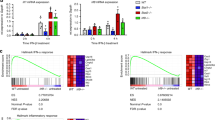Abstract
ONE of the members of the bZIP family of transcriptional activators1–5 is NF-IL6/LAP (IL-6 DBF, C/EBPβ CRP2). NF-IL6/LAP protein is highly expressed in liver nuclei2, where it has been implicated as a master regulator of the acute-phase response1,3,6,7, induced by interleukin-6 (IL-6) and other inflammatory mediators3,8. Also, NF-IL6/LAP is involved in the activation of the IL-6 promoter in response to IL-1 and bacterial lipopolysaccharide1–6. The control of NF-IL6/LAP expression and activity is complex and poorly understood. Under some conditions the NF-IL6/LAP gene is transcriptionally activated by IL-1 and lipopolysaccharide1, whereas in other instances, its binding to cognate DNA sequences is enhanced by cytokines1,3. Additionally, the ability of constitutively expressed NF-IL6/LAP to activate transcription is strongly augmented by IL-6, through an unknown signalling pathway. We now show that stimulation of the protein kinase C pathway increases the phosphorylation of Ser 105 within the activation domain of NF-IL6/LAP, and enhances its transcriptional efficacy.
This is a preview of subscription content, access via your institution
Access options
Subscribe to this journal
Receive 51 print issues and online access
$199.00 per year
only $3.90 per issue
Buy this article
- Purchase on Springer Link
- Instant access to full article PDF
Prices may be subject to local taxes which are calculated during checkout
Similar content being viewed by others
References
Akira, S. et al. EMBO J. 9, 1897–1906 (1990).
Descombes, P., Chojkier, M., Lichtsteiner, S., Falvey, E. & Schibler, U. Genes Dev. 4, 1541–1551 (1990).
Poli, V., Mancini, F. P. & Cortese, R. Cell 63, 643–653 (1990).
Cao, Z., Umek, R. M. & McKnight, S. L. Genes Dev. 5, 1538–1552 (1991).
Williams, S. C., Cantwell, C. A. & Johnson, P. F. Genes Dev. 5, 1553–1567 (1991).
Isshiki, H., Akira, S. & Tanabe, O. Molec. cell. Biol. 10, 2757–2764 (1990).
Poli, V. & Cortese, R. Proc. natn. Acad. Sci. U.S.A. 86, 8202–8206 (1989).
Darlington, G. J., Wilson, D. R. & Lachman, L. B. J. Cell Biol. 103, 787–793 (1986).
Mukaida, N., Shiroo, M. & Matsushima, K. J. Immun. 143, 1366–1371 (1989).
Hensel, G., Meichle, A., Pfizenmaier, K. & Krönke, M. Lymphokine Res. 8, 347–351 (1989).
Nishizawa, M., Tsuchiya, M., Watanabe-Fukunaga, R. & Nagata, S. J. biol. Chem. 265, 5897–5902 (1990).
Metcalf, D. & Nicola, N. A. Leukemia Res. 9, 35–50 (1985).
Seelentag, W. K., Mermod, J.-J., Montesano, R. & Vassali, P. EMBO J. 6, 2261–2265 (1987).
Evans, E., Courtois, G. M., Killan, P. L., Fuller, G. M. & Crabtree, G. R. J. biol. Chem. 262, 10850–10854 (1987).
Ray, A., Tatter, S. B., May, L. T. & Sehgal, P. B. Proc. natn. Acad. Sci. U.S.A. 85, 6701–6705 (1988).
Castagna, M. et al. J. biol. Chem. 257, 7847–7851 (1982).
James, G. & Olson, E. J. Cell Biol. 116, 863–874 (1992).
Descombes, P. & Schibler, U. Cell 67, 569–579 (1991).
Boyle, W. J., van der Geer, P. & Hunter, T. Meth. Enym. 201, 110–149 (1991).
Müller, C. R., Maire, P. & Schibler, U. Cell 61, 279–291 (1990).
Sadowski, I. & Ptashne, M. Nucleic Acids Res. 17, 7639 (1989).
Li, L. et al. Cell 71, 1181–1194 (1992).
Brenner, D. A., O'Hara, M., Angel, P., Chojkier, M. & Karin, M. Nature 337, 661–663 (1989).
Boyle, W. J. et al. Cell 64, 573–584 (1991).
Binetruy, B., Smeal, T. & Karin, M. Nature 351, 122–127 (1991).
Smeal, T., Binetruy, B., Mercola, D., Birrer, M. & Karin, M. Nature 354, 494–496 (1991).
Gonzalez, G. & Montminy, M. R. Cell 59, 675–680 (1989).
Karin, M. & Hunter, T. Cell 70, 375–387 (1992).
Metz, R. & Ziff, E. Genes Dev. 5, 1754–1766 (1991).
Gauldie, J., Richards, C., Harnish, D., Lansdorp, P. & Bauman, H. Proc. natn. Acad. Sci. U.S.A. 84, 7251–7256 (1987).
Dignam J. D., Lebovitz, R. M. & Roeder, R. G. Nucleic Acids Res. 11, 1475–1489 (1983).
Author information
Authors and Affiliations
Rights and permissions
About this article
Cite this article
Trautwein, C., Caelles, C., van der Geer, P. et al. Transactivation by NF-IL6/LAP is enhanced by phosphorylation of its activation domain. Nature 364, 544–547 (1993). https://doi.org/10.1038/364544a0
Received:
Accepted:
Issue Date:
DOI: https://doi.org/10.1038/364544a0
This article is cited by
-
High-fat diet-induced diabetes couples to Alzheimer’s disease through inflammation-activated C/EBPβ/AEP pathway
Molecular Psychiatry (2022)
-
C/EBPβ-Thr217 Phosphorylation Stimulates Macrophage Inflammasome Activation and Liver Injury
Scientific Reports (2016)
-
Increased HCMV seroprevalence in patients with hepatocellular carcinoma
Virology Journal (2011)
-
The CCAAT/enhancer binding protein (C/EBP) δ is differently regulated by fibrillar and oligomeric forms of the Alzheimer amyloid-β peptide
Journal of Neuroinflammation (2011)
-
Prolonged Use of Aspirin Alters Human and Rat Intestinal Cells and Thereby Limits the Absorption of Clopidogrel
Clinical Pharmacology & Therapeutics (2011)
Comments
By submitting a comment you agree to abide by our Terms and Community Guidelines. If you find something abusive or that does not comply with our terms or guidelines please flag it as inappropriate.



